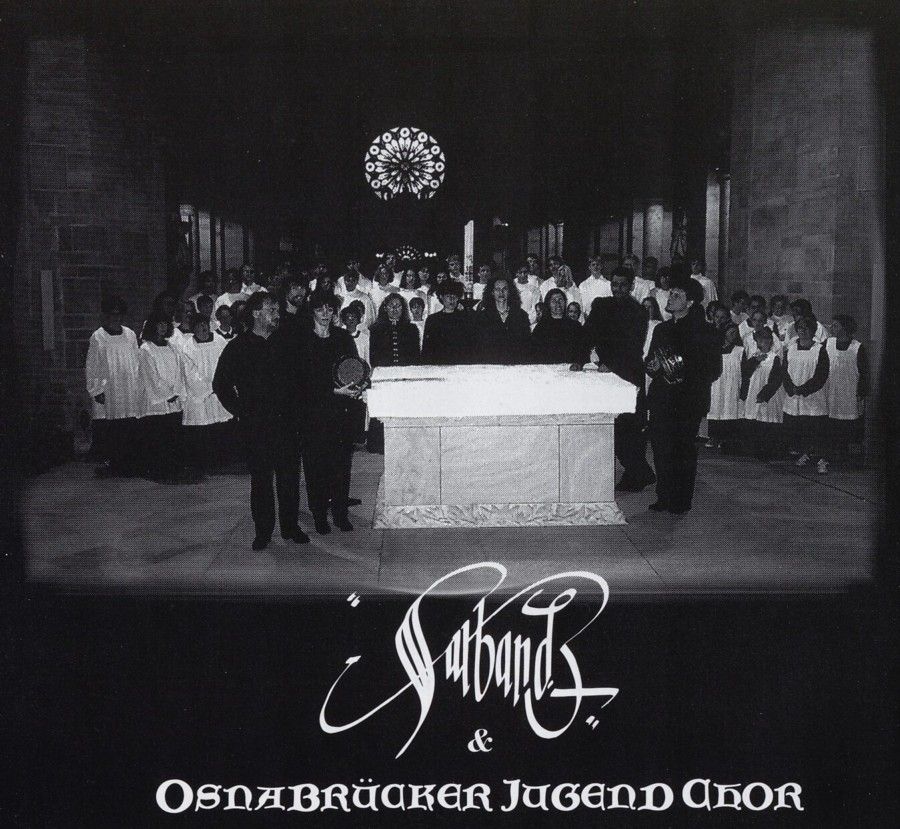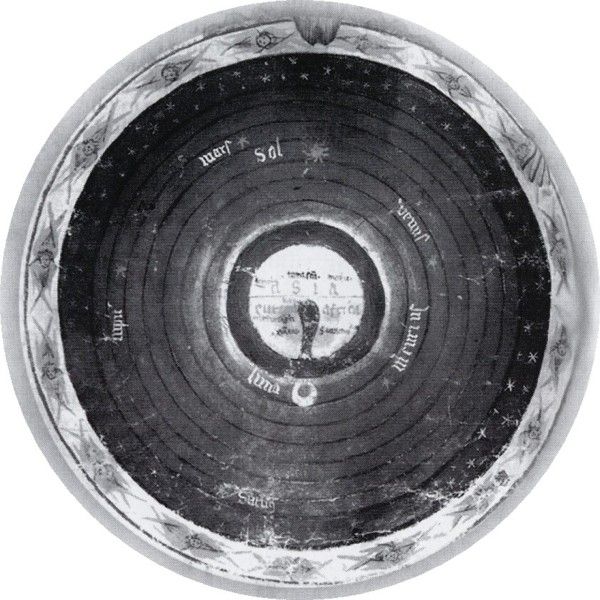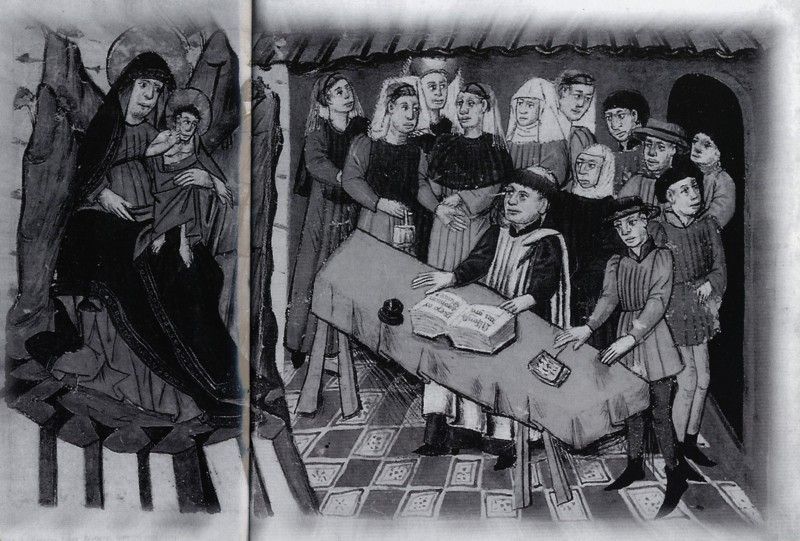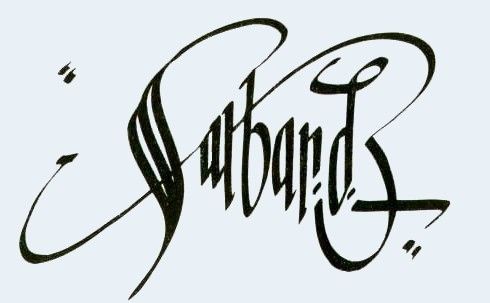Llibre Vermell de Montserrat / Sarband & Osnabrücker Jugend Chor
Cants dels Romeus · Medieval Pilgrim Songs from Spain

medieval.org
Jaro 4171-2
1993
2000: Dorian DOR-93202
1. O Virgo spendens [4:50]
a. Choral — b. Canon a 3 ·
LV 1 · fol. 21v
2. Laudemus virginem [2:34]
Canon a 3 ·
LV 3 · fol. 23
3. [4:00]
Salve Virgo — virelai, Codex Ripoll
Splendens ceptigera — Canon a 3 ·
LV 4 · fol. 23
4. Cedit frigus [1:23]
conductus / virelais a 1, Codex Ripoll, fol. 108
5. Polorum regina [5:50]
a 3 · LV 7 · fol. 24v
6. Mariam matrem [8:33]
virelais a 3, a. vocal — b. instrumental ·
LV 8 · fol. 25
7. Inperayntz ~ Verges ses par [2:02]
virelais a 2, instrumental ·
LV 9 · fol. 25v
8. Stella splendens [6:44]
virelais a 2 ·
LV 2 · fol. 22v
Instrumental prelude:
CSM 48 ·
CSM 52 ·
CSM 57 ·
CSM 113 ·
CSM 302 ·
CSM 311
9. Los Set Gotxs [5:33]
balada a 1 ·
LV 5 · fol. 23v
10. Ad mortem festinamus [4:32]
Totentanz · Danse macabre ·
LV 10 · fol. 26v
11. O Virgo Splendens [3:05]
organum ·
LV 1 · fol. 21v
12. Cedit frigus [3:50]
conductus / virelais a 2, Codex Ripoll, fol. 108v
13. Cuncti simus [5:51]
virelais a 2 ·
LV 6 · fol. 24
14. Inperayntz ~ Verges ses par [4:22]
virelais a 2, vocal ·
LV 9 · fol. 25v

SARBAND
Vladimir Ivanoff
SOLISTISCHE STIMMEN | VOCAL SOLOISTS:
Rose Bihler-Shah, Fadia El-Hage, Cornelia Melián, Catherine Rey
INSTRUMENTALISTEN | INSTRUMENTALISTS:
Paolo Cecere – Vielle, Hurdy-gurdy, Shawm, Psaltery
— Fidel, Drehleier, Schalmei, Psalterium
Marika Falk – Medieval and Arab Percussion
— Mittelalterliche und Arabische Perkussion
Ian Harrison – Cornetto, Shawm, Vielle, Bagpipes
— Zink, Schalmei, Fidel, Dudelsack
Mehmet Yesilçay – Oriental Lute, Frame Drums
— Ud, Rahmentrommeln
Vladimir Ivanoff – Portative Organ, Medieval Lutes, Medieval and Arab Percussion
— Portativ, Mittelalterliche Lauten, Mittelalterliche und Arabische Perkussion
CHOR | CHOIR
OJC: Osnabrücker Jugend Chor & Domkantorei
Youth Choir Osnabrück & Cathedral Choir
MUSIKALISCHE LEITUNG | MUSICAL DIRECTION:
Vladimir Ivanoff: SARBAND — Johannes Rahe: OJC
ALLE ÜBERTRAGUNGEN UND ARRANGEMENTS |
ALL TRANSCRIPTIONS AND ARRANGEMENTS: Vladimir Ivanoff
AUFNAHME | RECORDING:
May 1993
Dom von Osnabrück | Osnabrück Cathedral
Jochen Scheffter · Vladimir Ivanoff
Masterings: Tonstudio Ulli Krauss, Musikhochschule München
PRODUZENTEN | PRODUCERS:
Ulrich Balss &midot; Vladimir lvanoff
ARTWORK
FUEGO-Ateliers · Friedel Muders

MONTSERRAT
Medieval
Spain had two famous places of pilgrimage: Santiago de Compostella and
Santa Maria de Montserrat. Situated on a cleft mountain peak near
Barcelona, the monastery of Montserrat was the center of devotion for
the Virgin Mary for all of Catalonia
The monastery of Montserrat
was founded ca. 1025 as a branch of the Benedictine monastery of Ripoll.
Legend tells us that the Virgin Mary performed miracles there which
explains the fact that the mountain had been inhabited by hermits as
early as the end of the ninth century. During this time the mountain was
reconquered from the Saracens and conveyed to the monastery of Ripoll
by the counts Wifredo and Suner. The monastery of Santa Maria de
Montserrat originated out of one of the hermitages. A large number of
pilgrims went there, mainly because of their belief in the
wonder-working power of the black statue of the Virgin Mary which was
put up around the year 1200. The monastery was also a cultural center of
the first order: some of the monks had studied at far away universities
like Paris or Bologna. Clerics from noble Spanish families, mostly from
Catalonia, represented the aristocracy in Montserrat through their
celebration of daily Masses.
This is how Montserrat became the spiritual, cultural and political center of Catalonia.
With
the conquests of the Catalan-Aragonese crown, Montserrat became
"famous" worldwide: Churches were built in honour of the Virgin of
Montserrat in Mexico, Chile and Peru. In the colonies, islands and
settlements were named after her. After the almost complete devastation
of the monastery by Napoleon in 1811, Montserrat regained its former
significance only during the Catalonian "Renaixença" at the end of the
19th century.

LLIBRE VERMELL
The most precious
treasure from the library at Montserrat is a codex from the late 14th
century, the 'Llibre Vermell' or 'Red Book'. The manuscript is named
after its red velvet cover which stems from the late 19th century. 35 of
the original 172 sheets in folio of this manuscript are lost today.
Besides various other contents, mainly for liturgical use, one of the
fascicles of the Llibre Vermeil (folio 21v-27r) contains ten musical
works (notated during the years 1396-1399).
CANTS DELS ROMEUS
-pilgrim songs-
The anonymous scribe explains the intended function of the pieces which were copied by him:
Quia
interdum peregrini quando vigilant in ecclesia Beate Marie de Monte
Serrato volunt cantare et trepudiare, et etiam in platea de die, et ibi
non debeant nisi honestas ac devotas cantilenas cantare, idcirco
superius et inferius alique sunt scripte. Et de hoc uti debent honeste
et parce, ne perturbent perseverantes in orationibus et devotis
contemplationibus [..]
As it happens that the pilgrims, while
holding night vigil in the church of the Blessed Virgin from Montserrat,
sometimes desire to sing and to dance, and even so during the day on
the Church Square, where only virtuous and pious songs may be sung, some
suitable songs have been written down here for this need. These should
be used in a respectful and moderate manner, so as not to disturb those
who wish to continue their prayers and religious contemplations.
Since
the monastery of Montserrat did not have a pilgrims hostel, the
visitors spent the night in the church, thus rearranging the liturgical
room into a hostel. The songs of the Llibre Vermell were meant to replace the traditional secular songs and dances performed by the celebrating pilgrims during the night vigil.
 Fitting to this task, the Cants dels Romeus,
the songs of the pilgrims, have a popular tone. Some Spanish
traditional melodies were probably also used, but their original lyrics
were substituted by religious texts which should communicate essential
points of the Christian doctrine of salvation to the faithful. The
erudite and well-travelled monks from Montserrat also combined musical
influences from different European regions. They created a unique
amalgamation of simple Spanish folk melodies and complex, courtly
compositional techniques from Italy and France, maybe with the help of
musicians from the internationally composed royal chapel of Aragon.
Perhap individual pieces already existed as courtly songs and were
provided with religious lyrics by the monks.
Fitting to this task, the Cants dels Romeus,
the songs of the pilgrims, have a popular tone. Some Spanish
traditional melodies were probably also used, but their original lyrics
were substituted by religious texts which should communicate essential
points of the Christian doctrine of salvation to the faithful. The
erudite and well-travelled monks from Montserrat also combined musical
influences from different European regions. They created a unique
amalgamation of simple Spanish folk melodies and complex, courtly
compositional techniques from Italy and France, maybe with the help of
musicians from the internationally composed royal chapel of Aragon.
Perhap individual pieces already existed as courtly songs and were
provided with religious lyrics by the monks.
The opening choral O virgo splendens
(tracks 1 & 11) seems to be a liturgical chant but is, in reality
it a skilful 'composition' from different textual and musical sources,
amongst others the antiphon O virgo visa. The melodic structure allows it to be performed as a two- or three-voice canon. The same is true for Laudemus virginem (track 2) and Splendens ceptigera (track 3). The title of caça, common to all of these pieces, shows their relationship with the French chasse and the Italian caccia.
The two-part Stella splendens (track 8) cites from the lyrics of the opening O virgo splendens. The two-voice structure, notation and text structure of this virelais dearly show influences of the French Ars Nova.
In our performance, we use two similar chants from the monastery of Ripoll as instrumental interludes: the two-part conductus Cedit frigus (tracks 4 & 12) and the Salve virgo regia (track 3). Stella splendens
is introduced by an instrumental prelude, in which the melodies of the
six Cantigas de Santa Maria (approx. 1300) describing the miracles of
the Virgin of Montserrat are used (track 8).
The songs Stella splendens, Los set gotxs and Polorum regina are explicitly titled as round dances in the manuscript. Ad mortem festinamus tells us through its text that is a death dance.
Many
medieval documents — especially from Spain and Southern France — tell
us about dances in church and during liturgical service.
The
unrestrained dances in church, which were sometimes accompanied by the
fiddles and shawms of jugglers and minstrels, led to prohibitions and
restrictions by the Church. In the year 1209 the Council at Avignon
decided:
Statuimus ut in sanctitum vigiliis in ecclesiis historicae
saltationes obscoeni motus seu choreae non fiant nec dicantur amatoria
carmina vel cantilenae ibidem.
We decide, that during the night
vigils for the Saints, the minstrels should neither perform dances with
obscene movements in the churches, nor should love-songs and similar
chants be performed.
Los set gotxs (track 9) is the first extant song in the Catalan language; the form of the text is similar to the Provençal balada.
Polorum regina (track 5) and Cuncti simus concanentes (track 13) are both virelais in terms of their form. The melody of Polorum regina is still cited in 1577 by the Spanish music scholar Salinas as the folk song Yo me yva mi madre.
Mariam matrem (track 6), a virelais with a texted melody and two accompanying voices without text, and the double-texted Imperayntz / Verges ses par (tracks 7 & 14) follow the style of the French Ars Nova.
The text of the death dance Ad mortem festinamus (track 10) is derived from the poem Contemptus mundi (1267). With its absurdly joyful melody and the deliberately false accented Latin text (Ad mortem festinamus) instead of (Ad mortem festinamus), this death dance is the only known example which shows an attempt to musically demonstrate the medieval concept of the monde renversé, the world upside-down, symbol for the vanity of secular hierarchy in the face of the hereafter.
VLADIMIR IVANOFF

[Dorian 93202]

"Sarband is certainly the most original Ensemble in Early Music."
—Neue Musikzeitung
The
name Sarband stems from Persian and Arabic, and denotes the improvised
joining of two parts of a musical suite. Vladimir Ivanoff founded the
ensemble Sarband in 1986 and has been pursuing an archaeology of complex
connections ever since. Above all, Sarband endeavors to point out
possible links between European music and the Islamic and Jewish musical
cultures. With sensitivity and intensity, Sarband celebrates the
symbiosis of Orient and Occident. The continuous musical collaboration
among the members of the ensemble ensures that a dialogue on equal terms
is maintained. It is the exchange of practical musical experience
between musicians from different cultures that make the performances of
Sarband fascinating, lively and extremely authentic.
In their
performance of European and Oriental medieval music, the Turkish,
Italian, English, Bulgarian, Arab and German musicians participating in
this project draw upon the colorful palette of instruments, vocal and
instrumental techniques and the art of improvisation which are still to
be found in Islamic culture today. Sarband's unique repertoire has won
them wide acclaim internationally. Over the past few years Sarband has
performed at numerous international festivals of varying orientations
ranging from Early Music to Avant-garde.
Sarband's musicians do
not regard their work as something sporadic but as an expression of
being and life. Just as religious, economic, cultural and political
differences between the Orient and the Occident play a predominant role
in today's society, Sarband's work endeavors to show that music has
always served t a medium of reciprocal respect, and can continue to do
so today: a model for peace.
 VLADIMIR IVANOFF
VLADIMIR IVANOFF
Vladimir
Ivanoff, founder and director of Sarband, was born in Bulgaria, studied
lute and historical performance practice at the Schola Cantorum
Basiliensis, and received his doctorate in musicology in Munich.
ha
his musical and musicological careers Vladimir Ivanoff has been
passionately dedicated to exploring and illuminating the cultural
threads between the Eastern and Westem Worlds. He has been particularly
active in bringing to light the cultural influences of Turkish and
Arabic music on Westem medieval music both through the contacts
surrounding the Crusades and mingling of cultures in Spain before 1492.
This quest has led him to work actively with traditional musicians from
Turkey and Lebanon in the evolution of a vibrant and revelatory style
for the performance of medieval music including repertoire from Eastern
Europe, music of the Sephardic Jews, Spanish sacred music and more. He
has trained in percussion with a number of traditional musicians.
In
addition to his work with Sarband, Vladimir Ivanoff is the director of
several other ensembles including "Vox", "L'Orient Imaginaire" and
"Metamorphoses." He has concertized widely and been involved in
theatrical projects, radio, television and CD production all over Europe
and in the United States and Canada. He has performed at the Boston
Early Music Festival, the Library of Congress and has been featured on
the US Public Radio program Harmonia. He was the producer of the
recordings by Mystère des Voix Bulgares, Megapolis, Elka Atanasova, and
of many other CDs in Early, Traditional, Electronic and Pop music; as
producer he has received two Grammy nominations.





 Fitting to this task, the Cants dels Romeus,
the songs of the pilgrims, have a popular tone. Some Spanish
traditional melodies were probably also used, but their original lyrics
were substituted by religious texts which should communicate essential
points of the Christian doctrine of salvation to the faithful. The
erudite and well-travelled monks from Montserrat also combined musical
influences from different European regions. They created a unique
amalgamation of simple Spanish folk melodies and complex, courtly
compositional techniques from Italy and France, maybe with the help of
musicians from the internationally composed royal chapel of Aragon.
Perhap individual pieces already existed as courtly songs and were
provided with religious lyrics by the monks.
Fitting to this task, the Cants dels Romeus,
the songs of the pilgrims, have a popular tone. Some Spanish
traditional melodies were probably also used, but their original lyrics
were substituted by religious texts which should communicate essential
points of the Christian doctrine of salvation to the faithful. The
erudite and well-travelled monks from Montserrat also combined musical
influences from different European regions. They created a unique
amalgamation of simple Spanish folk melodies and complex, courtly
compositional techniques from Italy and France, maybe with the help of
musicians from the internationally composed royal chapel of Aragon.
Perhap individual pieces already existed as courtly songs and were
provided with religious lyrics by the monks.

 VLADIMIR IVANOFF
VLADIMIR IVANOFF